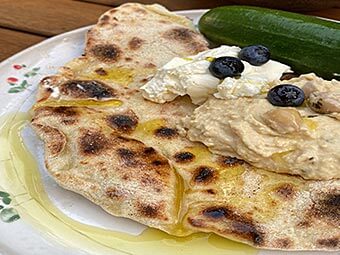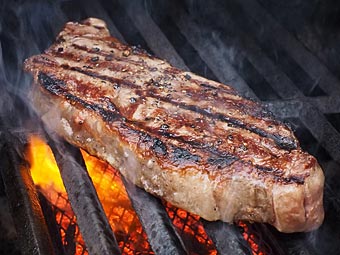
Beef has a long history in the human diet. Cattle were hunted and their meat used as food as early as the Stone Age. Over the millennia, the breeding and husbandry of cattle has evolved, and beef is now one of the most important types of meat in the world. In Europe, beef became the main meat for the upper classes in the Middle Ages, while the poorer classes subsisted primarily on pork and poultry. In the 19th century, beef production increased greatly in Europe and North America, and beef became an important ingredient in working-class cuisine.
Table of contents:
- Cook the perfect steak
- Core temperatures for beef steaks
- What goes well with beef steak?
- What is Dry Aged Beef?
- Chateaubriand – the fillet of beef
- What is a Steak Tomahawk
- Is roast beef and entrecôte the same thing?
- The difference between roast beef and rump steak
- Cook rump steak sous-vide
- What are chateaubriand, entrecôte, rump steak, T-bone steak, porterhouse steak, rib-eye steak, sirloin steak, tournedos
- Now it's your turn, your support is needed
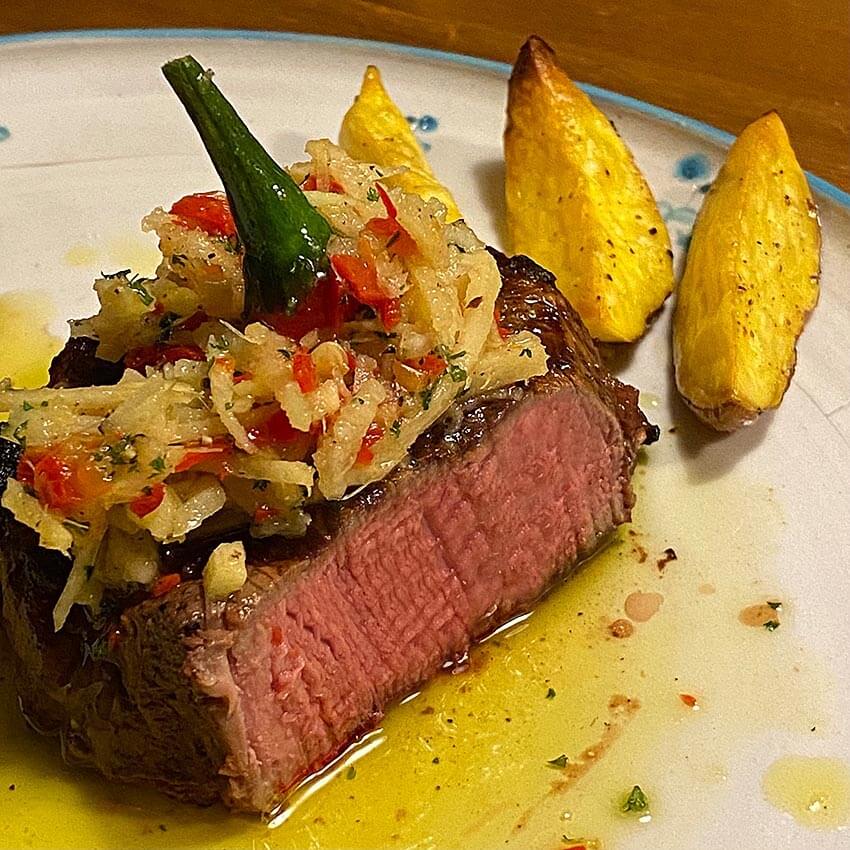
Cook the perfect steak
If you follow the steps below, you will achieve the perfect beef steak.
- If possible, only buy beef from a heifer or ox, preferably from your trusted butcher. Oxen are male, castrated cattle, heifers are female cattle that have not yet given birth to a calf. Cuts such as rib-eye, T-bone, porterhouse, rump steak or strip steak are ideal.
- It should be hung for a good 3-5 weeks, 3-5 cm thick and finely marbled. Beef, which has a high percentage of intramuscular fat, is very popular. The muscle fat melts, so to speak, at low temperatures. The beef therefore roasts in its own fat.
It is prepared as follows:
You can serve your steak cold, i.e. directly from the refrigerator place in the pan or on the grill. This means that you can quickly get a wonderful crust with high heat and the inside won’t dry out as quickly.
Season it before grilling or frying with fine Sea Salt Flakes.
Prepare steak in the pan:
Let the pan get really hot. A thick, cast iron pan with a smooth inner base is best. The surface of the pan should be 150 to 200 degrees hot. Add some clarified butter or peanut oil to the pan. Now sear just one steak on the left half of the pan for 30 seconds. When turning, place the steak on the right half of the pan and fry for 30 seconds. I repeat this 1-2 times. So always turn it into the hot area of the pan, so you get an incredibly beautiful crust.
Prepare steak on the gas grill:
Make sure the grill is properly preheated before putting the meat on. With a gas grill the temperature should be set to medium-high to high. Now sear the steak 2 x 30 seconds on each side.
Prepare steak on the charcoal grill:
In the charcoal grill, the charcoal should be completely glowing and give off a fair amount of heat. Now sear the steak 2 x 30 seconds on each side.
Into the oven:
We continue in a preheated oven (fan oven!) at 100 degrees (if there is time) or 150 degrees (if you want to go faster). So we slowly bring it to a core temperature of 54 degrees. Personally, I always stay about 8-10 degrees below the desired target core temperature, i.e. about 44 degrees.
Use a meat thermometer to monitor the core temperature of the meat. Insert the thermometer into the side of the thickest part of the steak to measure the exact temperature.
Do not place your steak on the baking tray, but rather on the wire rack. If you were to place your steak directly on the baking tray, it would swim in the “eggy soup” again and you would lose the beautiful crust. Under no circumstances wrap the steak in aluminum foil! This would only speed up the cooking process. Your steak is, so to speak, swimming in the meat juice and cooking through far too quickly. Goodbye crust.
For the second time – get to the crust:
If you want to eat your steak with a core temperature of around 54 degrees (ideal), then take it out of the oven at a core temperature of around 44 degrees. Now let’s make crust for the second time. Because up to this point your steak has released some water again. We dry the crust, so to speak, with the second frying.
Bring a pan (no matter what kind) to temperature (at least 150 degrees) and fry your steak again for a maximum of 20-30 seconds on each side. Also in clarified butter with herbs such as garlic, rosemary and thyme.
The rest period:
Now take the steak out of the pan and let it rest unwrapped for about 3-4 minutes. It will increase by about 1-3 degrees on its own. Roughly speaking, it takes about 1 minute per cm of steak thickness. If possible, always monitor with a meat thermometer until the core temperature is 54 degrees.
The cut:
Always cut your steak diagonally. Looks good and can be fanned out nicely. A little salt and pepper on top – Bon Appetit.
With these tips, you should be able to enjoy perfectly grilled beef in just over 45 minutes!
Preparation time: 1 hour
Quantity: 4 people
Cuisine: American
Core temperatures for beef steaks
- 46°C to 48°C: Blue Rare (bleu): lukewarm, raw kernel, red juice
- 49°C to 52°C: Rare (saignant): warm, red core, red juice
- 53°C to 57°C: Medium rare (anglais): light red, soft core, red juice
- 58°C to 60°C: Medium (à point): pink, medium soft core, pink juice
- 61°C to 65°C: Medium well (demi-anglais): pink-gray, firm core, clear juice
- above 66°C: Well done (bien cuit): gray, relatively firm, clear juice
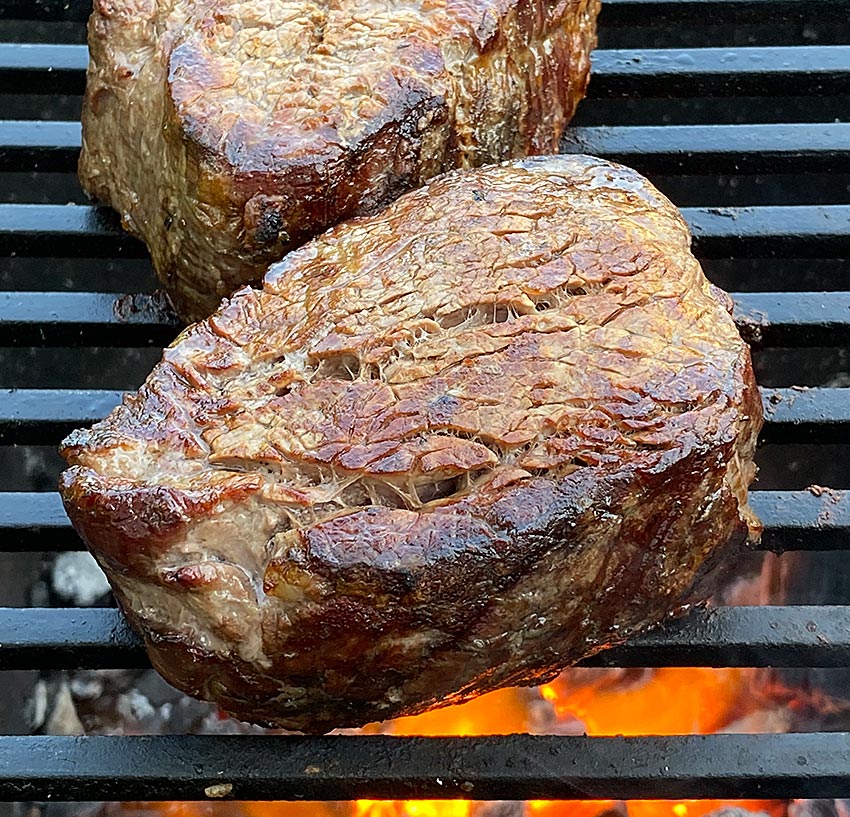
What goes well with beef steak?
There are many side dishes and ingredients that go well with beef steak and can complement the flavor of the steak. Here are some options:
- Vegetables: Grilled or fried vegetables such as asparagus, peppers, zucchini, Aubergine or mushrooms go well with beef steak. You can also use steamed or fried vegetables such as broccoli, carrots or a> serve.
- Potatoes: Potatoes are a popular side dish with steak. You can serve potatoes in different forms such as fried potatoes, mashed potatoes, French fries or potato gratin.
- Rice: Rice, but also risotto, is a good alternative with potatoes and goes well with steak. You can serve plain white rice, brown rice, or wild rice.
- Salads: A light salad can perfectly complement the steak. A simple green salad with vinaigrette dressing or a tomato salad with basil and olive oil are good options.
- Dips: Even a simple dip goes wonderfully with beef
- Bread: A slice of fresh bread or baguette can be used for dipping in the sauces or for absorbing the steak flavor.
Ultimately, the choice of side dishes and ingredients depends on your personal taste and preferences.
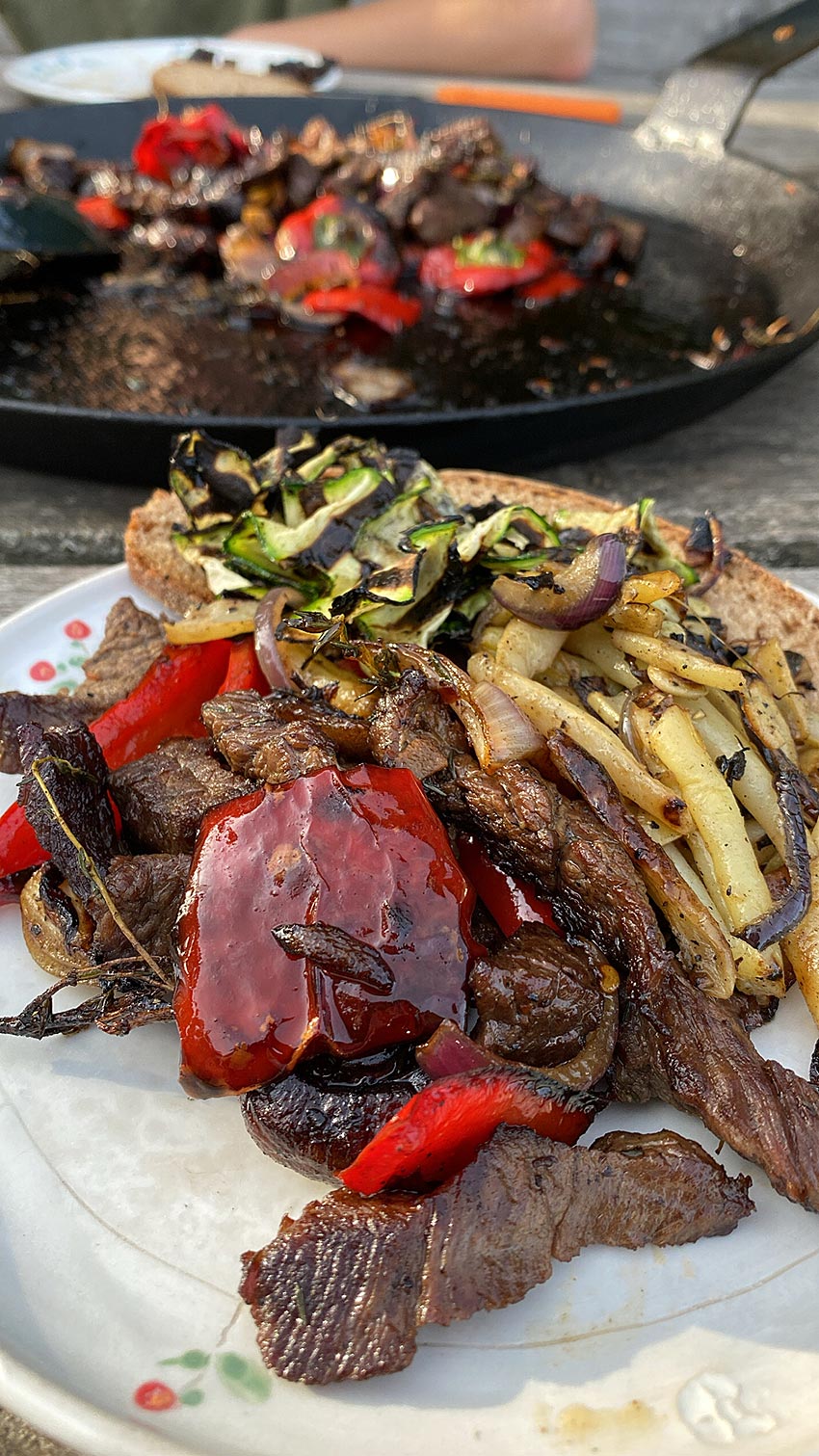
What is Dry Aged Beef?
Dry Aged Beef is a special type of meat aging in which the beef is dry aged in a controlled environment at low temperature and high humidity. During the ripening process, the meat becomes more tender and more flavorful due to the evaporation of moisture and the natural enzymatic processes in the meat.
The duration of the dry aging phase can vary depending on the desired taste and texture of the meat. However, it is usually between 21 and 60 days. As it ages, the meat develops a dark, dry, hard crust that must be removed before the meat is cooked. Dry aged beef is typically more expensive than conventionally aged meat because the aging process takes longer and requires greater control and monitoring. However, the taste of the meat is usually more intense and nuttier than conventionally aged meat.
Dry Aged Beef is often prized by gourmets and gourmet chefs because it has a special quality and texture and is considered a type of culinary delicacy. It is also often served in upscale restaurants and steak houses.
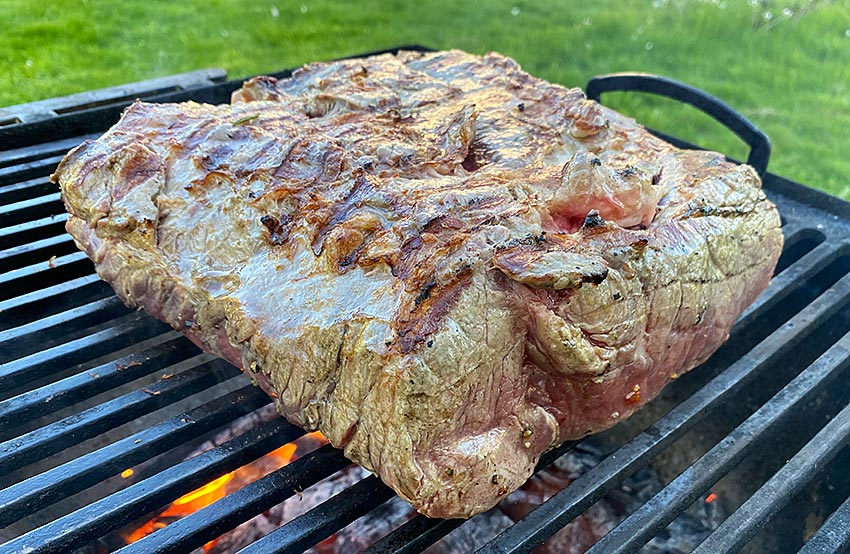
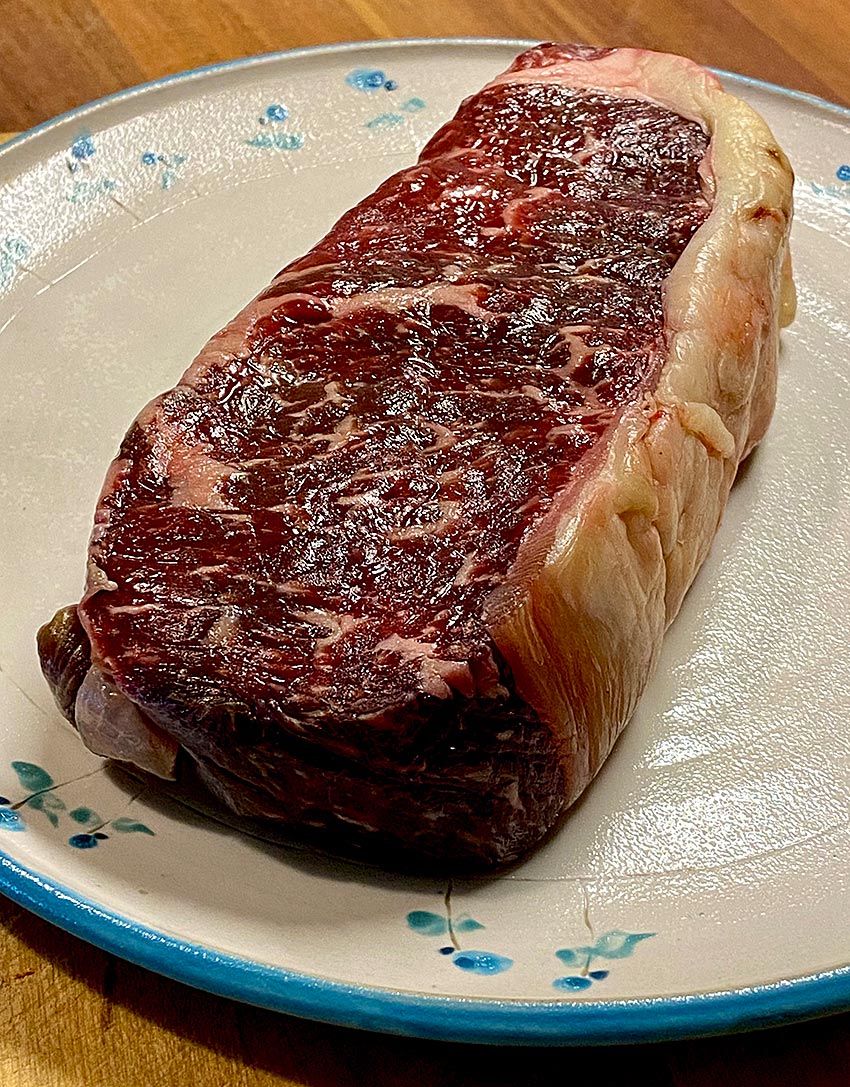
Chateaubriand – the fillet of beef
Chateaubriand is a thick cut of the tenderloin of beef, often served for special occasions or as a main course in upscale restaurants. It is named after the French writer and diplomat François-René de Chateaubriand, who was famous in the 19th century and is also considered the founder of French Romanticism.
Chateaubriand is usually prepared for two people and consists of a single piece cut from the center of the fillet. It is traditionally grilled or fried and served with a sauce made from broth, red wine, butter and spices such as thyme and bay leaves. Typical accompaniments to Chateaubriand are vegetables, potatoes or French fries. Considered a delicacy due to its tenderness and delicate flavor, Chateaubriand is typically a more expensive option on the menu. It is also a challenging dish that requires some experience in the kitchen to prepare perfectly.
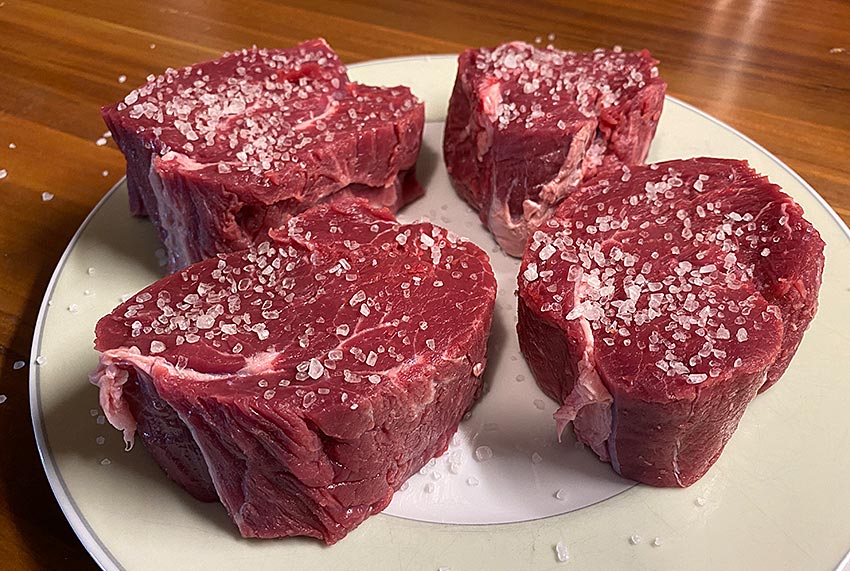
What is a Steak Tomahawk
A tomahawk steak is a cut of beef cut from the rib cage that resembles the bone of a tomahawk. It is a very large steak, weighing 1.2 to 2 kilograms and is usually suitable for two to three people. Tomahawk steak is cut from the front part of the beef’s back and contains part of the long back muscle, the rib bone and the fat eye. Due to the bone structure and the fat eye, the tomahawk steak is particularly juicy and flavorful. It is often grilled or pan-grilled and then further cooked in the oven to achieve a perfect crust and a juicy texture on the inside. It is usually simply seasoned with salt and pepper and served with side dishes such as vegetables, potatoes or salad.
The tomahawk steak has gained popularity in recent years and is often featured as an impressive dish for special occasions or as a special specialty in fine dining restaurants. However, it is also an expensive cut of meat and requires some experience in the kitchen to prepare it perfectly.
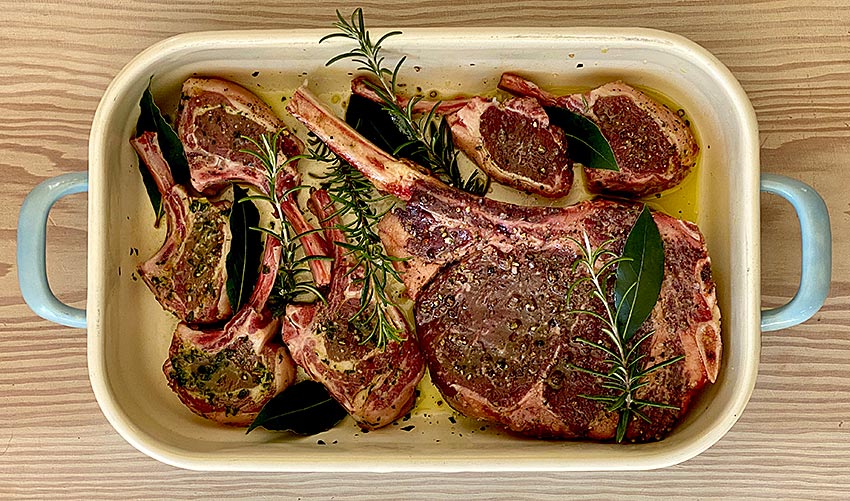
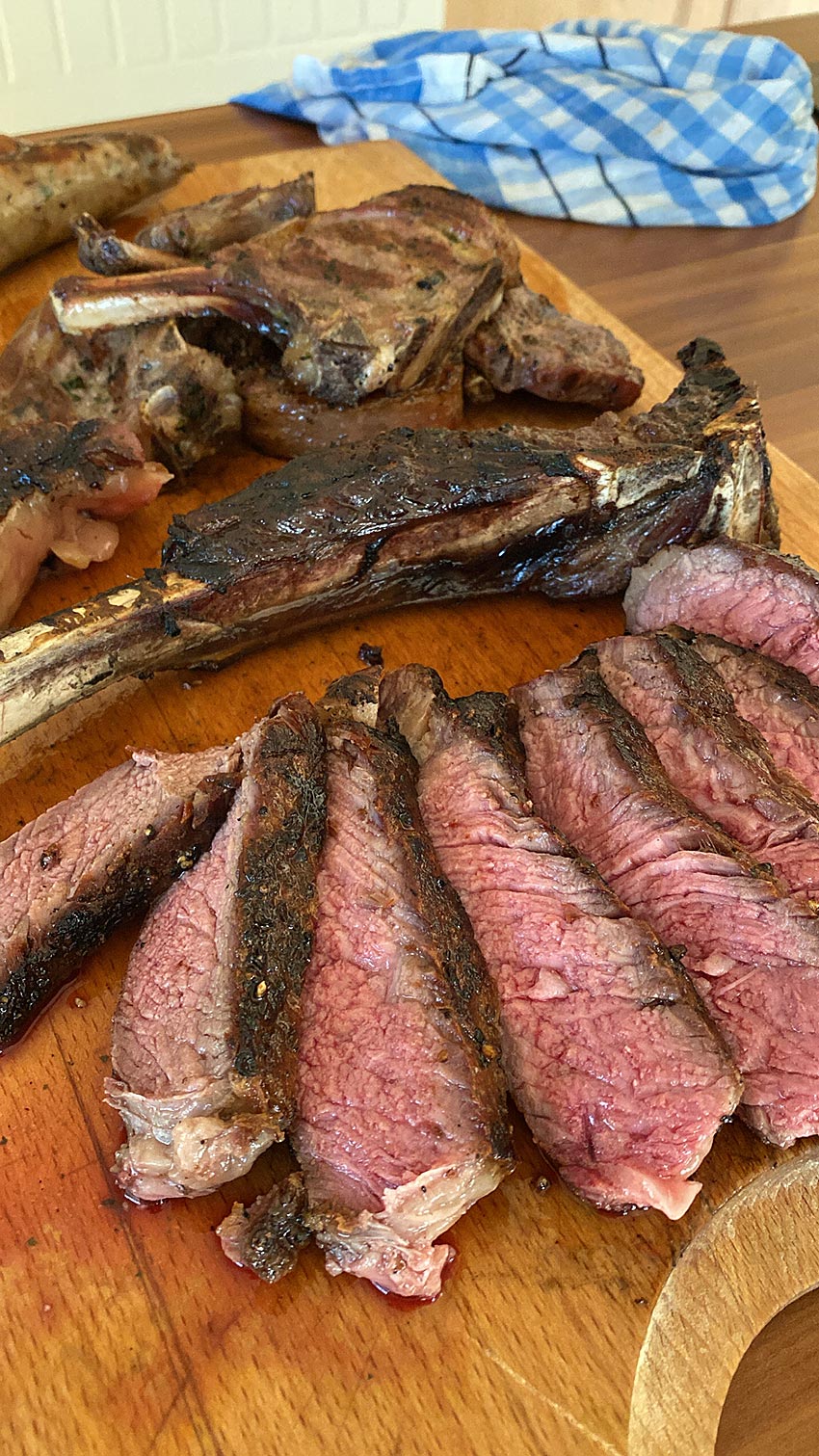
Is roast beef and entrecôte the same thing?
Roast beef and entrecôte are two different cuts of beef. Roast beef comes from the back of the beef loin and is a lean, boneless cut of meat. It is tender and juicy and is ideal for roasting in the oven or on the grill. Entrecôte, also known as ribeye steak, is also a cut of meat from the back, but it comes from the front part, more precisely from the rib cage of the animal. Entrecôte has more marbling compared to roast beef, meaning the meat contains more veins of fat. This makes it particularly juicy and has a more intense taste. Entrecôte is often grilled or fried and is a popular choice in fine dining restaurants.
In summary, roast beef and entrecôte are two different cuts of beef that differ in fat content, taste and preparation options.

The difference between roast beef and rump steak
Roast beef and rump steak are both popular and delicious cuts of beef, but they have some differences in texture, flavor and preparation. Roast beef is a cut from the back part of the cow, more specifically from the back muscle. It is known for its delicate texture and mild taste. Roast beef is usually oven-roasted or grilled and served as a whole slice, which is then cut into thin slices. It is a very versatile meat that goes well with a variety of side dishes.
Rump steak, on the other hand, comes from the back of the beef loin, directly above the roast beef. It is known for its rich depth of meat and strong flavor. Rump steak is usually grilled or pan-fried and is often served rare or medium rare due to its thickness and firmness. It is often served with a simple sauce or steak seasoning to enhance the flavor. The rump steak is a popular choice for steak lovers and is often served at barbecues or steak restaurants. It can be prepared in a variety of ways including grilled, fried, or cooked sous-vide. Depending on the region or cuisine, there are different names for the rump steak, for example strip steak, entrecôte or sirloin steak.
Overall, roast beef and rump steak differ in terms of their texture, taste and preparation methods. Roast beef is more tender and milder, while rump steak is firmer and has a stronger taste. However, both are delicious options for meat lovers and can offer different flavor and texture profiles depending on your preference and preparation method.
Cook rump steak sous-vide
Cooking rump steak sous-vide is a great way to prepare the meat to perfection and ensure it remains tender and juicy. Here are the steps you can follow:
- Season the rump steak: Rub the steak generously with salt and pepper, or season it with other spices, herbs or marinades as desired.
- Vacuum sealing: Seal the rump steak in a vacuum bag. If you don’t have a vacuum sealer, you can also seal the bag by placing the meat as close to the end of the bag as possible and then slowly submerging it in a pot of water, letting the pressure of the water force most of the air out of the bag repressed.
- Cook sous vide: Heat a pot of water to the desired temperature (depending on the thickness of the steak and the desired doneness), usually between 52 and 60 degrees Celsius for medium rare to medium. Add the sealed bag of rump steak to the water and cook for at least 1 hour and up to 3 hours.
- Fry briefly: Remove the rump steak from the vacuum bag and pat it dry with a paper towel. Cook the steak in a skillet with hot oil or on a grill for a minute per side to form a crust and warm it a little more.
- Serve: Let the steak rest for a few minutes to distribute the juices throughout the meat before slicing thinly and serving.
Rump steak cooked sous-vide is very tender and juicy and retains its natural taste and aromas. It’s a great way to cook a perfect steak at home.
What are chateaubriand, entrecôte, rump steak, T-bone steak, porterhouse steak, rib-eye steak, sirloin steak, tournedos
These are different types of beef steaks with different characteristics and flavor profiles.
- Chateaubriand: A Chateaubriand steak is cut from the sirloin of beef and is typically a thick cut that is enough for two or more people. It has a smooth, juicy texture and a rich, buttery flavor.
- Entrecôte: The entrecôte is a steak that is cut from the rib of beef. It is usually a thick steak with a high fat content, which gives it a rich, flavorful aroma. It is often referred to as a rib-eye steak.
- Rump steak: A rump steak is cut from the back of the beef loin and has a strong, meaty flavor. It is usually a tender and juicy steak that develops a nice crust when cooked correctly.
- T-Bone Steak: A T-Bone steak is a large steak that consists of a T-shaped bone and usually consists of two parts: the fillet and the strip. Steak. The fillet is more tender and has a milder flavor, while the strip steak has a stronger flavor due to its higher marbling.
- Porterhouse Steak: The porterhouse steak is similar to the T-bone steak, but contains a larger proportion of fillet and is also larger in size. Often referred to as the “King of all Steaks,” it is a popular choice for meat lovers due to its size and rich flavor.
- Rib-eye steak: A rib-eye steak comes from the front part of the back of beef and is particularly juicy and flavorful due to its high fat content. It often has a marbling of fat that gives the steak a rich flavor and tender texture.
- Shank steak: A skirt steak is cut from the hip muscle of the beef and has a strong flavor. It is a lean steak with a fine grain and a delicate texture.
- Tournedos: Tournedos are small, tender steaks that are cut from the fillet of beef. They have a mild, buttery flavor and are a popular choice for gourmet dishes.
Each of these types of steak has its own unique characteristics and is prepared in different ways to achieve their best flavors and textures.
Now it's your turn, your support is needed.
Did you like the post "How to cook the perfect steak"?
Simply select the number of stars and click. Thank you very much for your review ![]()
You might also be interested in this
Bake naan bread without yeast – basic recipe for Indian flatbread from the pan
Naan bread is a traditional flatbread popular in many countries in South Asia, particularly in Indian cuisine. It is often served with dishes such as curries or as a side dish to various meals. Naan bread is known for its…




